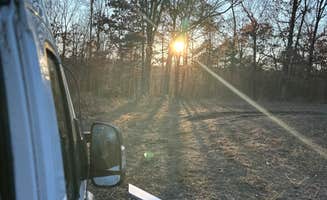Dispersed camping near Miami, Oklahoma offers remote locations with minimal facilities for self-sufficient campers. The area's varied terrain spans prairie expanses and wooded sections with elevation changes ranging from 750 to 900 feet above sea level. Seasonal considerations include high humidity in summer months and occasional burn restrictions throughout drier periods.
What to do
Fishing opportunities: Montgomery State Fishing Lake provides accessible shoreline fishing without developed facilities. "Free spot on a State fishing lake. Nice view well kept. Spots all around lake. Pit toilet, 1 trash can if you can find it," reports a camper at Montgomery State fishing lake.
Wildlife viewing: Early mornings and evenings offer prime wildlife observation times at conservation areas. "Stopped for an overnight on the way home. The spots are pull offs, circles and small lots of gravel. Saw several deer across the lake at dusk, eating grass," notes a visitor at Montgomery State Fishing Lake Dispersed.
Trail exploration: Several primitive trails connect camping areas to natural features. "Coordinates looks like it drops you off at the middle of the road but there is a gravel drive. Brings you to a grass lot with a trail off of it," explains a camper at Huckleberry Ridge Conservation Area.
What campers like
Accessibility to supplies: The proximity to towns provides security for campers who forget essential items. "I loved it! It's so quiet and peaceful. Very close to town so you never have to miss anything you may have forgotten. And heck its free!" shares an enthusiastic visitor about the convenient location.
Natural setting: The undeveloped character of these sites appeals to campers seeking minimal human presence. "Pretty remote. Quiet. Tick dog tried to get through the tick gate but failed unfortunately. No table. Burn ban, so no fires. No ticks. Hard to get to in the dark, but nice scenery," explains a tent camper about their experience.
Low traffic noise: Despite proximity to roads, many sites maintain a sense of separation from traffic sounds. "Can hear K but only a few cars go up and down it. Can't see cars on K from the lot. Very cozy!" mentions a camper about the auditory environment at their camping location.
What you should know
Site maintenance variations: Rustic camping areas near Miami, Oklahoma have inconsistent upkeep. "Rarely used site! Nice woods. Might want to bring a weed wacker," advises a camper, suggesting bringing tools for site clearing if needed.
Limited amenities: Prepare for primitive conditions with no standard campground facilities. "No toilets or trash pickup. The area was actually very clean," reports a visitor describing the basic conditions.
Navigation challenges: Reaching dispersed sites often requires advance planning or daylight arrival. "Hard to get to in the dark, but nice scenery," cautions a camper about timing arrival properly.
Tips for camping with families
Safety preparation: Bring comprehensive first aid supplies as medical facilities remain distant from primitive camping areas. Pack extra water, insect repellent, and sun protection particularly during summer months when temperatures regularly exceed 90°F.
Wildlife education opportunities: Use wildlife tracking guides specific to Oklahoma and Missouri species for educational activities with children. Morning walks offer chances to identify animal tracks and native plants around camping areas.
Weather monitoring: Oklahoma weather patterns change rapidly, requiring constant awareness of conditions. Pack clothing layers for temperature fluctuations between day and night, which can vary by 30°F in spring and fall.
Tips from RVers
Access limitations: Most dispersed camping areas near Miami have unimproved roads unsuitable for larger recreational vehicles. Small to medium-sized camper vans and truck campers navigate these areas most successfully.
Site selection: Arrive during daylight hours to properly assess ground conditions and overhead clearance. RVers report needing to scout multiple potential spots before finding suitable level areas with firm ground.
Self-contained systems: With no hookups or dump stations, RVers must arrive with full water tanks and empty holding tanks. Plan for 2-3 days maximum stay based on typical tank capacities and consumption rates.



